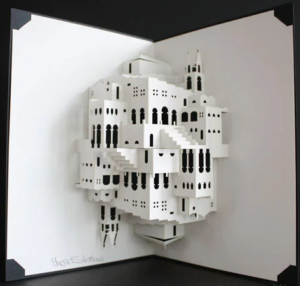My first thought was to tell a story focused on polymorphic colonial organisms, which are organisms that are made up of individuals units, or zooids that have different specialities. For example, zooids may be responsible for feeding, defense, navigation or reproduction. In order for the larger organism to survive, the individuals need to all exists, and work together. Another classification of colonial organisms are chimera colonies, which are many sub-colonies of closely-related, but not genetically identical. There are theories that the diversity in the chimera colonies has advantages in being more resilient to environmental threats.
I haven’t been sure about what metaphor to use, because a lot of my ideas have been pretty literal. I was thinking of presenting an organism with different jobs. And in this way, I was hoping that the form I chose to have some movement. My first thought was to create a guide that takes inspiration from Parable of the Polygons by Vi Hart and Nicky Case, and to create a website that allows the user to move components around the screen. But then I realized that I spent so much time in front a computer, and maybe it would be a useful exercise to create something more tangible, and less technical. During the summer session, I noticed that I sometimes struggled to be creative at my computer. Since I write code for work, it’s sometimes challenging to turn my analytical, work-focused brain off, and be creative when writing code.
When brainstorming about analog ways to tell a story of movement, I came to the idea of creating a pop up book. This seemed like a good way to show movement in a paper form. After doing a bit of preliminary research, I realized that this is also a very technical skill, that will require my analytical mind. But, it’s away from a screen, and doesn’t require my fingers to be on a keyboard, so I think that it may be a good choice for my own creativity.
Now I am thinking a bit more critically about the metaphor I want to use, and how a pop up book may enhance that narrative. To sum up the metaphor that I keep coming back to, in the style that Lakoff and Johnson use in Metaphors to Live By, it would be “diversity is good”. I also keep realizing that though my form and the specific narrative will be different, the over all theme and metaphor is very similar to Parable of the Polygons. I like the idea of using Hart and Case’s general premise, but doing it in a different form. I think that the pop up form will be a bit limiting, mostly because it is new to me, and I will likely not be able to tell such a full story due to time limitations and lack of skill. But, I think if I focus on reimagining this first interaction of Parable of the Polygons, I can still create an effective guide.

It would be interesting to show different elements (zooids?) that when they get closer together, they become “happy”, and when they’re further apart they are sad. Maybe something like this:

I wonder if this is too similar to Parable of the Polygons, and if there is something different I can do to bring the narrative a bit more closely tied to colonial organism, and biology, and kinship. Potentially, I could borrow the ideas I learned from Margaret about slime mold, and their potential self-sacrificing behavior.
I also wanted to add a couple images of my first pop up experiments. These were created by following the Duncan Birmingham’s first two tutorials in The Popup Channel on youtube.







